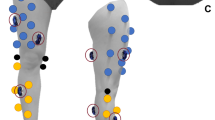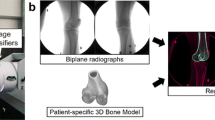Abstract
Coactivation of knee flexors during knee extension assists in joint stability by exerting an opposing torque to the anterior tibial displacement induced by the quadriceps. This opposing torque is believed to be generated by eccentric muscle actions that stiffen the knee, thereby attenuating strain to joint ligaments, particularly the anterior cruciate ligament (ACL). However, as the lengths of knee muscles vary with changes in joint position, the magnitude of flexor/extensor muscle force coupling may likewise vary, possibly affecting the capacity for active knee stabilization. The purpose of this study was to assess the effect of changes in movement speed and joint position on eccentric/concentric muscle action relationships in the knees of uninjured (UNI) and post-ACL-surgery (INJ) subjects (n = 14). All subjects were tested for maximum eccentric and concentric torque of the contralateral knee flexors and extensor muscles at four isokinetic speeds (15°–60° · s−1) and four joint position intervals (20°–60° of knee flexion). Eccentric flexor torque was normalized to the percentage of concentric flexor torque generated at each joint position interval for each speed tested (flexor E-C ratio). In order to estimate the capacity of the knee flexors to resist active knee extension, the eccentric-flexor/concentric-extensor ratios were also computed for each joint position interval and speed (flexor/extensor E-C ratio). The results revealed that eccentric torque surpassed concentric torque by 3%–144% across movement speeds and joint position intervals. The magnitude of the flexor E-C ratio and flexor/extensor E-C increased significantly with speed in both groups of subjects (P < 0.05) and tended to rise with muscle length as the knee was extended; peak values were generated at the most extended joint position (20°–30°). Although torque development patterns were symmetrical between the contralateral limbs in both groups, between-group comparisons revealed significantly higher flexor/extensor E-C ratios for the INJ group compared to the UNI group (P < 0.05), particularly at the fastest speed tested (60° · s−1). The results indicate that joint position and movement speed influence the eccentric/concentric relationships of knee flexors and extensors. The INJ subjects appeared to accommodate to surgery by developing the eccentric function of their ACL and normal knee flexors, particularly at higher speeds and at more extended knee joint positions. This may assist in the dynamic stabilization of the knee at positions where ACL grafts have been reported to be most vulnerable to strain.
Similar content being viewed by others
Author information
Authors and Affiliations
Additional information
Accepted: 28 January 1999
Rights and permissions
About this article
Cite this article
Osternig, L., James, C. & Bercades, D. Effects of movement speed and joint position on knee flexor torque in healthy and post-surgical subjects. Eur J Appl Physiol 80, 100–106 (1999). https://doi.org/10.1007/s004210050564
Issue Date:
DOI: https://doi.org/10.1007/s004210050564




